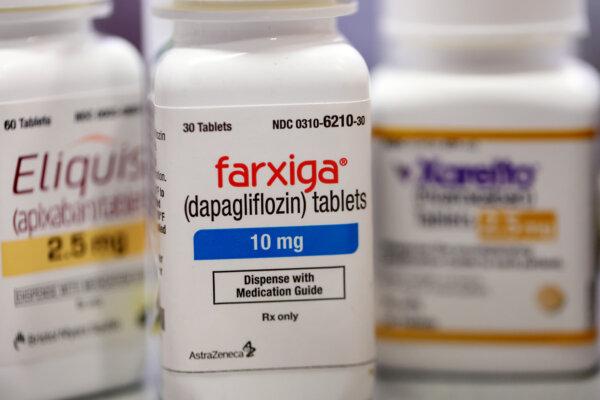Experts said the increase in health care costs is due to a combination of hospital consolidations, growing prescription drug prices, and an aging population.
“The tragic news of UnitedHealthcare’s CEO has opened a lot of discussion about the very nasty subject of health care costs and quality of service,” Mark Malek, chief investment officer at Siebert Financial, told The Epoch Times in an email.
The Federal Reserve has attributed elevated price pressures to services inflation, particularly in the housing sector, which accounts for a significant portion of the CPI report.
“Do you know what other services inflation consistently runs hot, well above the 2 [percent] guideline? Health care,” Siebert said.
The report forecasts that medical costs will increase by 8 percent from last year for the group market and by 7.5 percent for the individual market. If accurate, health care cost growth will be the highest in 13 years.
The research shows that private health insurance premiums have risen cumulatively by 15 percent since 2022 and that they are becoming more expensive in 42 states.
“In the health care sector, both rising employment levels and wage increases fueled by economy-wide inflation during the past few years are pushing health care costs higher,” Debbie Ashford, North America chief actuary for Health Solutions at Aon, said in a statement.
“To keep pace with these pressures, the health care industry negotiates higher prices, which in turn emerge as higher medical trends.”
National health care spending has garnered attention recently, with billionaire Elon Musk shining a spotlight on the exorbitant costs amid the Department of Government Efficiency (DOGE) initiative.
Musk reposted a Peter G. Peterson Foundation chart shared by the popular social media X account “The Rabbit Hole.” The data highlight administrative costs per capita of $1,055, the highest among the more than 100 Organisation for Economic Co-operation and Development countries.
The fiscal think tank estimated that U.S. health care spending reached $4.5 trillion in 2022, averaging $13,493 per person and accounting for 17 percent of gross domestic product (GDP).
Experts say the triple-digit percentage increase in health care costs is because of a combination of hospital consolidations, growing prescription drug prices, and an aging population.
“When the population is aging and getting sicker, it adds more strain to the health care system and just an overall shortage of healthcare workers,” Divya Sangameshwar, an insurance expert and spokesperson at LendingTree, told The Epoch Times.
“And this isn’t a new problem. Health care costs have been rising since the year 2000, and these costs are just ultimately getting caught down to policyholders in the form of higher premiums.”

Farxiga is made available to customers at the New City Halsted Pharmacy in Chicago on Aug. 29, 2023. Scott Olson/Getty Images
Medicare
In fiscal year 2024, the federal government spent $874 billion on Medicare.
As a result of an increasing number of seniors, Medicare enrollment is expected to surge in the coming years, adding to the ballooning costs of the federal program.
In March, the nonpartisan Congressional Budget Office projected that Medicare spending would play a sizable role in the significant increase in federal spending over the next 30 years. Medicare spending, the report concluded, will double over the next 30 years and reach 5.5 percent of GDP.
Health Care Consolidation
In recent years, there has been a prevalence of health care consolidation—hospitals, insurance companies, and other health care organizations joining together by either acquisitions or mergers—and industry observers say this is adding to price pressures across the marketplace.
Although this is not a new trend, it has accelerated in recent years, with nearly 1,900 hospital mergers between 1998 and 2021, according to the American Hospital Association.
Various assessments suggest that this has adversely affected the health care system, including the number of hospitals, according to experts.
“There are also indications that consolidation will reduce access to health care for the most vulnerable populations through hospital closures and higher prices in highly consolidated markets.
“Adding to that is the fact that private equity has entered the market amid predictions that the stresses of the COVID-19 pandemic will accelerate the pace of consolidation.”
The newest trend is that corporate giants such as Amazon, CVS, UnitedHealth, and private equity companies are acquiring many physician practices.
The U.S. government is beginning to take notice.
“Hospital consolidations often lead to worse outcomes for nurses and doctors, result in higher prices, and can have life and death consequences for patients,” Henry Liu, director of the FTC’s Bureau of Competition, said, noting that this deal could lead to higher out-of-pocket costs for essential health care services.
Administration
The costs of health care administration—billing and coding, insurance administration, and physician administrative activities—have contributed significantly to health care price inflation.
Although the numbers vary, data show that administrative costs represent a sizable share of total expenses incurred in delivering health care to patients.
Vivek Ramaswamy, co-head of DOGE, blames regulations and bureaucracy for high administrative costs.
“Most regulations ultimately hurt the very people they are supposed to ‘help,’” Ramaswamy wrote on X on Dec. 6.
“Many hospitals and health systems are forced to dedicate staff and clinical resources to appeal and overturn inappropriate denials, which alone can cost billions of dollars every year,” the report reads.
John Bright, founder and CEO of Med Claims Compliance Corporation, said costs associated with administrative errors can also add to the final tally.
Medicare maintains an improper payment rate—or claims overpaid in errors—that costs as much as $32 billion per year. According to Bright, this could be because of administrators not knowing the proper billing codes. The elevated improper payment rate can also be attributed to theft, fraud, waste, and abuse, he said.
“Health and Human Services has to factor in the improper payment rate,” Bright told The Epoch Times. “It’s kind of like if you own a grocery store, and you have to allocate the cost of what’s called shrinkage theft. You have to factor it into your cost of operation.”
The incoming administration, particularly Robert F. Kennedy Jr., wants to work with the American Medical Association to remedy this situation. The organization devises the billing codes and generates millions in revenue from royalties. RFK Jr. aims to update the system to bolster primary care and enhance health outcomes.
Original News Source Link – Epoch Times
Running For Office? Conservative Campaign Consulting – Election Day Strategies!


